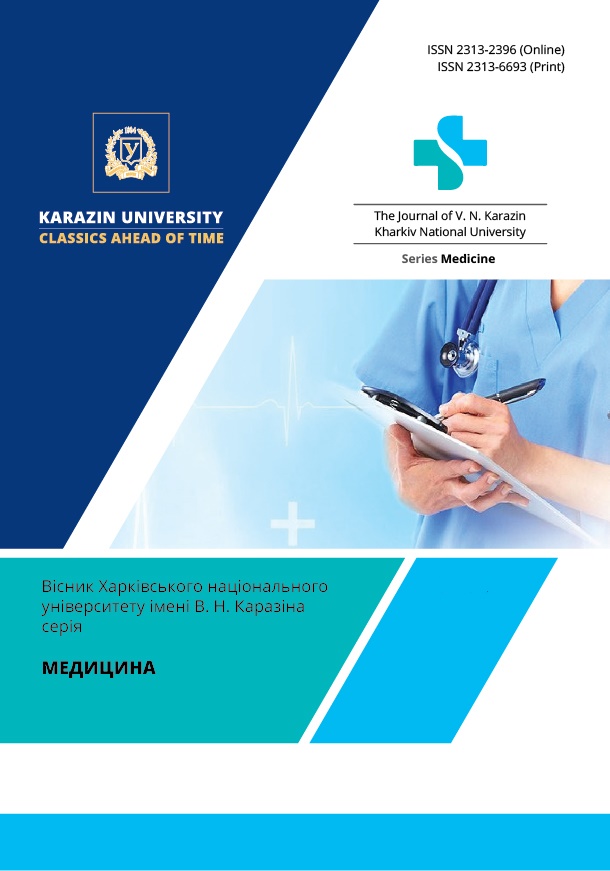Головний біль на фоні коронавірусної інфекції: особливості клінічної картини
Анотація
Вступ. Covid-19 постав новою проблемою сучасності. Захворюваність у світі стрімко збільшується, а з нею посилюється увага до вивчення механізмів патогенезу вірусу. З’являються нові симптоми персистенції SARS-CoV-2 в організмі людини. Встановлено, що не лише респіраторні прояви спостерігаються в інфікованих осіб, а дедалі більше на перший план постає неврологічна симптоматика. Основним і поширеним проявом інфікування Covid-19 є головний біль у перед- та пост-ковідному періоді. Визначення можливих шляхів потрапляння збудника в нервову клітину, встановлення особливостей Covid-асоційованого головного болю залишається актуальною проблемою медицини. Мета роботи. Проаналізувати дані світової наукової літератури стосовно можливих механізмів інвазії вірусу SARS-CoV-2 в нервову систему та їх вплив на розвиток головного болю у перед- та пост-ковідному періоді. Матеріали та методи. Проведений ретроспективний аналіз літератури наукових баз Scopus, PubMed, MedLines, Web of Science за 2020–2022 роки. Результати. Останні дані дослідників свідчать про нейровірулентність збудника. SARS-CoV-2 вражає людину, використовуючи рецептор ангіотензинперетворювального ферменту 2, який представлений в ольфакторній ділянці, корі головного мозку, базальних гангліях, гіпоталамусі, стовбурі головного мозку, ендотеліальних клітинах. Детальні механізми проникнення в центральну нервову систему ще не до кінця вивчені, однак розглядають наступні шляхи передачі: через нюховий нерв в подальшому вражається головний мозок, другий шлях – клітинна інвазія, інфіковані моноцити та макрофаги, що являють собою резервуар для вірусу для подальшого розподілення в інші тканини, наступний механізм – це інфікування ендотеліальних клітин гематоенцефалічного та епітеліальних гематолікворного бар’єра. Механізм появи головного болю дослідники пояснюють через пряму інвазію закінчень трійчастого нерва в порожнині носоглотки, що призводить до активації трійчасто-судинної системи. Головний біль спостерігається на початку захворювання та може тривати більше 180 днів після одужання. Він характеризується, як двосторонній, стискаючого характеру, триває годинами, стійкий до звичайних знеболюючих, посилюється вранці, при кашлі та фізичній активності. Висновки. Вірус SARS-CoV-2 призводить до інфікування, використовуючи АСЕ2-рецептори, частина, з яких локалізована у різних відділах ЦНС, що зумовлює виникнення неврологічної симптоматики. Головний біль є одним із найбільш виражених симптомів COVID-19, його характеристики та еволюція можуть відображати різні патофізіологічні механізми, що робить їх вивчення необхідним для ґрунтовнішого розуміння головного болю в перед- та пост-ковідному періоді та пошук варіантів для його усунення.
Завантаження
Посилання
The Human Protein Atlas. Available from: https://www.proteinatlas.org/ENSG00000130234-ACE2/brain
Varga Z, Flammer AJ, Steiger P, et al. Endothelial cell infection and endotheliitis in COVID-19 // Lancet 2020. Vol. 395 (10234). P. 1417 - 1418. DOI: https://doi.org/ 10.1016/S0140-6736(20)30937-5
Edoardo Caronna, Alejandro Ballvé, Arnau Llauradó, et al. Headache: A striking prodromal and persistent symptom, predictive of COVID-19 clinical evolution. Cephalalgia 2020 November; 40(13):1410-1421, DOI: https://doi.org/10.1177/0333102420965157
Migraine and Post-COVID Headache, American Migraine Foundation, February, 2022, Available from: https://americanmigrainefoundation.org/resource-library/migraine-post-covid-headache/
Bolay H, GuЁ l A and Baykan B. COVID-19 is a Real Headache! Headache 2020; 60: 1415–1421. DOI: https://doi.org/10.1111/head.13856
David García-Azorín MD, Javier Trigo MD, Blanca Talavera MD, et al. Frequency and Type of Red Flags in Patients With Covid-19 and Headache: A Series of 104 Hospitalized Patients. Headache, September 2020. Vol.60, P. 1664-1672 DOI: https://doi.org/10.1111/head.13927
César Fernández-de-las-Peñas, Marcos Navarro-Santana, Víctor Gómez-Mayordomo, et al. Headache as an acute and post-COVID-19 symptom in COVID-19 survivors: A meta-analysis of the current literature. European Journal of Neurology, November 2021, Volume28, P. 3820-3825, DOI: https://doi.org/10.1111/ene.15040
Вісник Харківського національного університету імені В. Н. Каразіна, серія Медицина має такі умови авторського права:
1. Автори зберігають авторські права та надають журналу право на першу публікацію разом із роботою, яка одночасно ліцензується згідно з ліцензією Creative Commons Attribution License, яка дозволяє іншим ділитися роботою з визнанням авторства роботи та першої публікації в цьому журналі.
2. Автори можуть укладати окремі додаткові договірні угоди щодо неексклюзивного розповсюдження опублікованої журналом версії роботи з підтвердженням її початкової публікації в цьому журналі.
3. Авторам дозволяється та заохочується публікувати свої роботи в Інтернеті до та під час процесу подання, оскільки це може призвести до продуктивного обміну, а також до раннього та більшого цитування опублікованої роботи.




